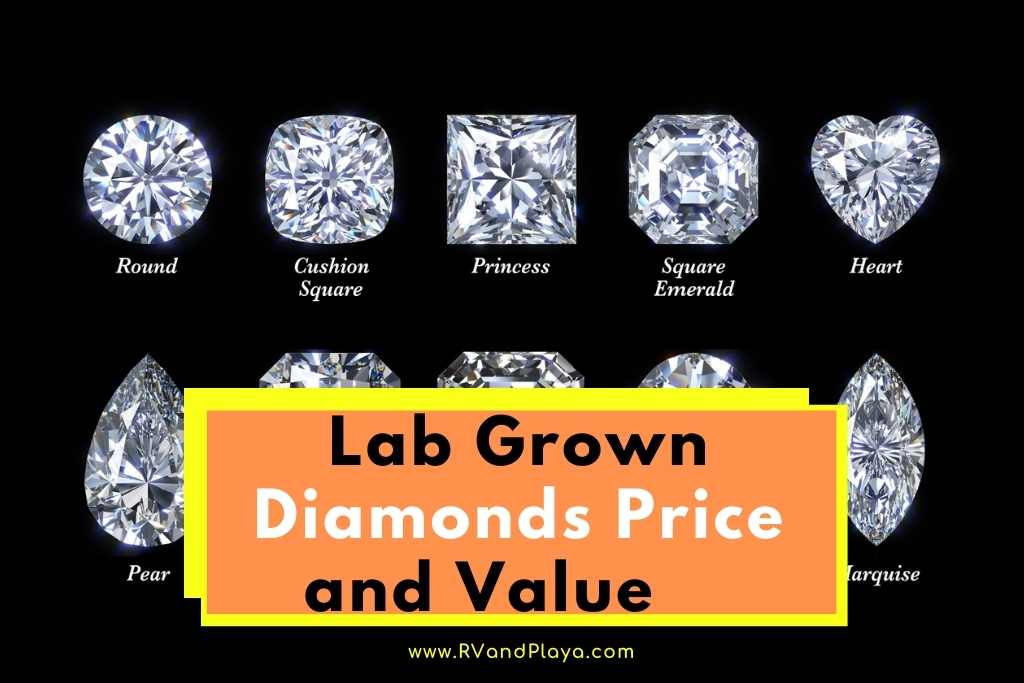Lab grown diamonds are real stones that are grown in a lot less time in a laboratory. They look just like natural diamonds and are more affordable.
Lab grown diamonds are priced more affordably than natural diamonds because they don’t take billions of years to form. They only take around 10 weeks to form. The price of a lab grown diamond costs about a third of the cost of a naturally occurring diamond of the same size and quality.
In this article, you’ll find all you need to know about the value of lab diamonds. We’ll look at the difference in values between lab grown diamonds and their natural counterparts.
Keep reading to see if a lab grown diamond might be ideal for you.
Table of Contents
What Makes Lab Created Diamond Different?
Lab grown diamonds are different because of the environment in which they’re grown. They form the same way under the same kind of conditions, meaning intense pressure and heat, but in different places.
Natural diamonds are formed deep down in the earth’s crust. Diamonds form from carbon that can be as deep as 125 miles under the surface. They take up to billions of years to form.
Lab grown diamonds are formed in a laboratory. They’re made of the same elements, except they never have nitrogen in them like some natural diamonds and are subjected to intense pressure and heat.
It only takes a couple of months for gemologists to create lab grown diamonds. They’ve studied natural diamonds for a long time and are able to keep them under the pressure and temperature needed to form the diamond without any break, so it happens much quicker.
Read also >> What Is A Lab Grown Diamond Called? (All You Need To Know)
Read also >> 2.5 Carat Lab Grown Diamond Price (Current Price)
Why Are Lab Created Diamonds Less Expensive?
Since we know how to create them essentially whenever we want, lab grown diamonds are less valuable. Some of the natural diamond’s value stems from the fact that it was made by the earth.
The rest of the value is based on the same thing natural diamonds are graded on. Gemologist graders use the 4 Cs to grade and/or certify lab grown diamonds just as they do natural.
How Much Are Laboratory Diamonds?
We mentioned above that lab grown diamonds carry about a third of the value of the same size natural diamond with the same quality level.
For example, a 1 carat natural diamond with an H color grade and an SI clarity grade would run about $6,100. That same diamond but lab grown would be around $1,830.
Here’s a reference chart to give you a better idea of the difference in price.
| Size | Price Diamond H Color | Price Diamond SI Color |
|---|---|---|
| 0.25 | $395 | $1,316 |
| 0.50 | $708 | $2,360 |
| 0.75 | $993 | $3,310 |
| 1.00 | $1,830 | $6,100 |
| 1.50 | $2,400 | $8,000 |
| 2.00 | $3,750 | $12,500 |
The hard thing about comparisons like this is that it’s tough to find two stones that are exactly alike in quality. They also may vary a little based on the grader that determined the value.
Are Lab Diamonds Perfectly Clear?
Lab grown diamonds may have inclusions just like natural diamonds. However, they do tend to be more clear than many natural diamonds.
Since they’re formed in a controlled environment, there isn’t the opportunity for outside elements to get into the stones. Nothing is around to disturb the growth process either.
This doesn’t mean lab grown diamonds don’t have any inclusions. The process includes forming them in a solution of molten metal.
For this reason, there are sometimes metal inclusions within the stones. They aren’t big enough to see with the naked eye, though.
- Save an Average of $350* on Lab-Created Diamonds
- James Allen is the leader in online diamond sales
Do These Diamonds Have Good Resale Value?
Diamonds grown in a lab aren’t as easy to resell, but it’s not impossible. You aren’t likely to get what you paid for it, though.
They’ve seen a steady drop in value in recent years. They currently sit at prices of about 50-70% of natural diamonds.
The best thing you can do is keep all of your paperwork for the diamond so if you decide to sell it, it will be easier to prove it’s real. Shoppers are extremely leery of scammers, so be ready to show your diamond’s information.
Are Lab Grown Diamonds as Hard as Natural Diamonds?
Lab grown diamonds have the same hardness as naturally occurring diamonds. Both are a level 10 on the Mohs Hardness Scale.
Lab grown are real diamonds, contrary to some mistaken beliefs. Comparing these two types of diamonds is not like comparing a natural diamond to a cubic zirconia or a clear quartz.
This is an apples to apples comparison, not an apples to oranges.
Should I Buy a Diamond Grown in a Lab?
You can’t tell the difference between a lab grown diamond and a natural diamond just by looking at them. They look the same.
Lab grown diamonds are usually sparkly due to their good clarity. Most are colorless unless they’ve undergone some other process to introduce color.
If you want more bang for your buck, go with a lab grown diamond. You can get a high quality 2 carat diamond for under $5,000 if you do.
Will a Diamond Tester Detect a Laboratory Diamond?
A diamond tester checks for thermal conductivity to determine if the stone is a real diamond.
Lab grown diamonds are made of carbon, just like natural diamonds, so they will yield a positive result from a diamond tester.
Are There Any Downsides to Lab Grown Diamonds?
The biggest downside to buying a lab grown diamond is associated with its value. Natural diamonds increase in value with time. Lab grown diamonds do not.
Mass produced diamonds lose value because more batches are created right behind the others. They’re not unique like natural diamonds, thus they don’t hold value.
Can I Buy a GIA Certified Lab Grown Diamond?
You can purchase a lab grown diamond that’s been certified by the GIA, or Gemological Institute of America. They grade these diamonds on the same scale used for natural diamonds.
Prior to 2019, the GIA would indicate it was a lab grown diamond by referring to them as synthetic somewhere on the diamond report.
They stopped using that term as it creates a false sense that the diamond isn’t real.
Do Lab Grown Diamonds Turn Yellow?
Just like natural diamonds don’t turn colors once they’re formed, neither do lab grown stones. Color would have to be introduced during the growth process for it to change the diamond.
Once it’s formed, that’s the color it will be forever.
If your diamond starts to look dull or foggy, it’s likely just dirty. You can clean it to get its sparkle back.
How Do I Clean a Lab Grown Diamond?
You can clean a lab grown diamond just like you would a natural diamond. Mix together some mild dish soap and warm water. Allow your diamond jewelry to soak in the solution for about 20 minutes.
If you’d like to give it a deeper clean, take a soft-bristled toothbrush or soft cleaning rag and gently clean your stone. Rinse thoroughly with water. Then, make sure you dry it completely.
Can I Wear My Diamond Jewelry Every Day?
Diamonds are used in engagement rings for good reason. They are the hardest natural substance on the Mohs Hardness Scale. They’re durable and will last a lifetime longer.
It’s also customary that married couples wear their wedding rings daily. Diamonds are durable so they’re ideal for everyday wear.
You should make a habit of cleaning the diamonds on a regular basis. Also, it’s not good to store jewelry in damp or humid spaces.
Bathrooms are not ideal for jewelry storage. When you’re going to shower or swim, you should also take your diamond jewelry off and leave it in another room that’s dry.
How Long Have Lab Grown Diamonds Been Around?
Lab grown diamonds were first introduced in the industrial sector in the 1940s and 1950s. They weren’t made for the retail sector until the 1970s, however.
In the 1970s, lab grown diamonds had the gem quality people looked for with jewelry. They’ve grown so popular now, you can find them in many different retail outlets and locations.
Can a Jeweler Tell a Diamond Is Lab Created?
Jewelers cannot tell if diamonds are lab grown or natural. They’re made of the same thing, grown under the same conditions, both have inclusions, and are cut the same way.
Some jewelers say they lean toward assuming it’s lab grown when there’s a lack of inclusions, just because that’s so rare in a natural diamond, but even that would be only an assumption.
Other than seeing it come out of the lab where it was created, there’s no way to tell the difference.
James Allen is the leader in online diamond sales. Their imaging technology is the same as inspecting a diamond with a jeweler's loupe. They have the largest exclusive loose diamond inventory online and fantastic prices.
They also have the nicest collection of lab created diamonds online. Save 10% off select lab grown diamonds and 25% off ring settings during limited time sale!
WHAT WE LOVE ABOUT THEM:
- No questions asked returns within 30 days of shipment. James Allen will send you a paid shipping label to return the ring.
- Lifetime Warranty
- Free International Shipping
- Free prong tightening, repolishing, rhodium plating and cleaning every 6 months
- Provide insurance appraisals
- One free resizing within 60 days of purchase
- Free ring inscriptions
- Best-in-class high quality imagery of all diamonds in stock
- 24/7 Customer Service
- Best-in-class packaging
Final Thoughts
Lab grown diamonds are real and just as beautiful as natural diamonds. They’re not nearly as pricey, though.
While they may be equal in quality and beauty, they don’t hold the same value that naturally occurring diamonds do because they’re mass produced.
Lab grown diamonds are a more affordable option for shoppers who don’t want to break the bank for their diamond jewelry.
References
https://www.gia.edu/gia-faq-grade-laboratory-grown-diamonds
https://www.gemsociety.org/article/brief-history-of-lab-grown-diamonds/
Recent Posts
Shopping for diamonds is a tricky business and trying to find something of significant size can become almost impossibly expensive. If you want to find some more affordable options, then you will...
When you're shopping for diamonds on a budget, you may be looking at lab created diamonds as a more affordable option than their naturally formed options. But with all the man-made options out...


